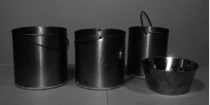Cooking Gear
During the mid-nineteenth century, the U.S. Army issued only the barest of cooking gear for each company. “Our cooking utensils, furnished by the government, were of the most primitive description,” recalled William Westervelt, a veteran of the 27th New York Infantry. “The kettles, mess pans and frying pans were all made of sheet iron.”1 In fact, the Quartermaster Department officially provided only three items for cooking.
The camp kettle was the most ubiquitous of the Army’s issued cooking gear. Looking more like a pail than a true kettle, this pot was used to boil beans, meat and other army food. Manufactured in three sizes that fit within each other for easier storage, two sets or six camp kettles were allowed for an infantry company of 45 men.
The Quartermaster Manual of 1865 provides a detailed description: “Camp kettles, – to be of 3 sizes made of good American sheet iron, and so as to fit into each other in nests of three, viz: – No. 1, the largest size, should be 12 inches diameter and 11¾ inches deep, and to contain 4½ gallons. No. 2, to be 10¼ inches diameter, 11¼ inches deep, and to contain 3½ gallons. No. 3, to be 9½ inches diameter, 11¼ inches deep, and to contain 2½ gallons. All to have iron wire bails, 5-16 of an inch diameter, the ends of which to be drawn down to a point. Weight of a nest of three kettles, 17 ¼ to 17 ½ pounds.”2
The second most important Army issued cookware was known as the mess pan, fifteen of which were allowed for a company of 45 men. These shorter pans were not intended for cooking; rather they were generally used for serving food. The Quarter-master Manual describes this item as follows: “Mess pans, – to be made of good American sheet iron, 11½ inches diameter at top, and 8½ inches at the bottom, 5¼ inches deep; to contain 5 quarts. Weight about 2 pounds.” Figure 1 illustrates the basic shapes of both the camp kettle and the mess pan.
Units stationed at garrisons such as those guarding Washington, D.C. or in temporary winter cantonments could also draw one iron pot per company. Because of their weight, they were not generally allowed in the baggage train in the field but they were valuable additions to the limited cooking gear when a unit was stationary.
The Quartermaster Manual describes these as: “Iron pots, – to be of cast iron, No. 9; diameter outside at top, 15 3/8 inches; depth inside, 11½ inches, with three legs on bottom, 3½ inches long; lug or ear on opposite sides of top, for the bail; the bail to be of round iron wire, 7-16 of an inch diameter. Weight of pot, completed, 35 to 37 pounds, and to contain 6 gallons.”
Together, these three items – the camp kettle, the mess pan, and the iron pot – were the standard issue cooking gear for enlisted men in the regular and volunteer army. Occasionally, other cooking items such as sheet iron frying pans were provided. But most often, any additional cooking equipment and utensils were purchased by the unit from their company fund.
To store and transport their cooking equipment, each company also had a wooden mess chest, clearly marked with their unit identification. No standard design was used but period photographs do show that they all shared some basic characteristics. So if you want to improve your Civil War encampment, consider adding the appropriate cook gear around your camp fire.
1. William B. Westervelt, Lights and Shadows of Army Life, as Seen by a Private Soldier (Marlboro, NY: C. H. Cochrane, 1886) p. 6.
2. Bvt. Maj. George H. Crosman, The 1865 Quartermaster Manual, edited by Earl J. Coates & Frederick C. Gaede (privately printed, 2013).






